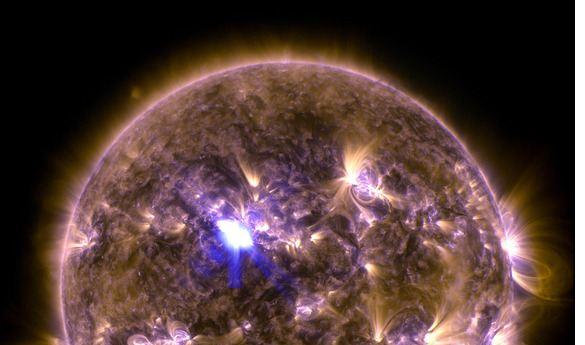Solar Maximum 2013
Most people think weather is just a term on Earth, but weather is everywhere. Weather even takes place outside of Earth, in space. A typical type of space weather involves solar flares. Did you know that on April 11, the most powerful solar flare of the year erupted from the sun? And did you also realize that there was a temporary radio blackout from it? Maybe you heard about the sudden Aurora Borealis of the east coast?
Be prepared for a year of intense solar activity. We are currently in the solar maximum year. Every 11 years, the sun shows large numbers of sunspots and the irradiance output grows. The increased solar output has shown to affect our climate and weather patterns in the past. During the solar maximum year, multiple solar flares will occur. So just what is a solar flare?
A solar flare is a sudden burst of brightness from the sun. It occurs when magnetic energy, which has built up in the solar atmosphere, is suddenly released. During a flare, radiation is emitted across the entire electromagnetic spectrum. The amount of energy released is equivalent to that of millions of 100-megaton hydrogen bombs exploding at the same time.
Scientists don’t just study solar flares for fun and games. The sun’s activity directly affects the Earth. Intense radiation from a solar flare can disrupt radio signals and even disturb a satellite’s orbit. Our atmosphere expands and ionizes every time a flare enters it. On a more positive note, however, did you know that auroras are enhanced and more defined during a solar weather event?
This past Thursday, a solar flare occurred. It just so happened to be the largest solar flare of the year. It occurred at 3:16 am. The flare was from extremely hot plasma, known as a coronal mass ejection. The ejection sent billions of solar particles through space that eventually reached Earth. Though this was only a mid-level flare, this should be taken as a warning for the future flares. It seems as though solar weather is beginning to vamp up as it heads towards the late 2013 solar maximum.
If you are checking out the C2M weather blog and I start talking about a solar flare, you’ll know just what’s going on. If you lose GPS or radio signal, blame the sun. It’s feeling pretty active this year. (Photo courtesy of nasa.gov).

